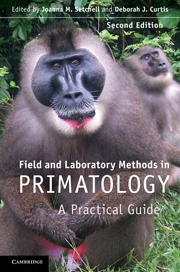Book contents
- Frontmatter
- Contents
- List of contributors
- Foreword by Robert D. Martin
- Introduction
- 1 An ethnoprimatological approach to interactions between human and non-human primates
- 2 Habituating primates: processes, techniques, variables and ethics
- 3 Habitat description and phenology
- 4 Geographical information systems and remote sensing
- 5 Monitoring local weather and climate
- 6 Survey and census methods: population distribution and density
- 7 Trapping primates
- 8 Handling, anaesthesia, health evaluation and biological sampling
- 9 Morphology, morphometrics and taxonomy
- 10 Marking and radio-tracking primates
- 11 Field experiments with non-human primates: a tutorial
- 12 Feeding ecology, frugivory and seed dispersal
- 13 Dietary analysis I: food physics
- 14 Dietary analysis II: food chemistry
- 15 Collecting arthropods and arthropod remains for primate studies
- 16 Recording primate vocalizations
- 17 Photography and video for field researchers
- 18 Chronobiological aspects of primate research
- 19 Thermoregulation and energetics
- 20 Field endocrinology: monitoring hormonal changes in free-ranging primates
- 21 Collection, storage and analysis of non-invasive genetic material in primate biology
- 22 Tips from the bush: an A–Z of suggestions for successful fieldwork
- Index
- References
9 - Morphology, morphometrics and taxonomy
Published online by Cambridge University Press: 05 June 2012
- Frontmatter
- Contents
- List of contributors
- Foreword by Robert D. Martin
- Introduction
- 1 An ethnoprimatological approach to interactions between human and non-human primates
- 2 Habituating primates: processes, techniques, variables and ethics
- 3 Habitat description and phenology
- 4 Geographical information systems and remote sensing
- 5 Monitoring local weather and climate
- 6 Survey and census methods: population distribution and density
- 7 Trapping primates
- 8 Handling, anaesthesia, health evaluation and biological sampling
- 9 Morphology, morphometrics and taxonomy
- 10 Marking and radio-tracking primates
- 11 Field experiments with non-human primates: a tutorial
- 12 Feeding ecology, frugivory and seed dispersal
- 13 Dietary analysis I: food physics
- 14 Dietary analysis II: food chemistry
- 15 Collecting arthropods and arthropod remains for primate studies
- 16 Recording primate vocalizations
- 17 Photography and video for field researchers
- 18 Chronobiological aspects of primate research
- 19 Thermoregulation and energetics
- 20 Field endocrinology: monitoring hormonal changes in free-ranging primates
- 21 Collection, storage and analysis of non-invasive genetic material in primate biology
- 22 Tips from the bush: an A–Z of suggestions for successful fieldwork
- Index
- References
Summary
INTRODUCTION
Fieldworkers are often unaware of the value of making accurate records of their study animals' morphology. External morphology includes measurements, observations of glandular activity and detailed description of the pelage; internal morphology may include skull and postcranial measurements, recording of suture closure, epiphyseal fusion, dental eruption and wear, and observations on the gut. All these observations will yield information on taxonomy, age–sex class (Table 9.1), reproductive status, individual variation, growth, development, sexual dimorphism and so on. It may also be interesting to look at individuals' behaviour in the light of their external differences: does facial coloration correlate with behaviour in mandrills (Mandrillus sphinx), does flange development correlate with behaviour in orangutans (Pongo spp.), and so on?
Measurements may be made either on dead specimens, or on living animals when they are captured (Chapter 7) and, preferably, anaesthetized (Chapter 8). Valuable descriptive information, other than measurements, can be gathered from simple observations, or from photographs (Chapter 17). On occasion, measurements can even be made in this way. For example, Markham and Groves (1990) cite a personal communication from Herman Rijksen of how he weighed four wild orangutans (worth repeating here because it is such a wonderful example of lateral thinking) ‘… by “measuring” the bending arc of particular branches when supporting the full weight of the animal and hoisting up buckets of sand to match the same arc’.
- Type
- Chapter
- Information
- Field and Laboratory Methods in PrimatologyA Practical Guide, pp. 169 - 188Publisher: Cambridge University PressPrint publication year: 2011
References
- 1
- Cited by

